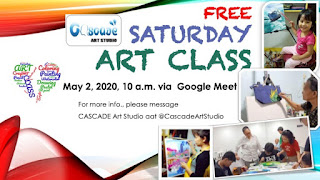| |
Drawing Inanimate Objects
|
As of the afternoon of May 9, from 3:00 p.m. to 3:45 p.m., we had a live feed on our FB Page @CascadeArtStudio. We continued with Lesson 2 of our Free Saturday Art Class while still on Enhanced Community Quarantine or ECQ.
For those unable to join or see the live feed, we have added it here in our blog for quick access and understanding for those who wish to learn how to draw. It may be for a hobby or to pass the time. But I hope this article helps you relieve boredom or help you discover your potential in drawing.
MATERIALS NEEDED:
- Drawing pencils
- Drawing pad
- Eraser
Let us start with our lesson.
To draw inanimate objects, you must remember the different shapes. Drawing would be easy if you could identify shapes by looking at pictures.
Now to illustrate, let us use the following picture as a reference:
Using your reference, sketch in the shape of the vases, using the lines and shape as your guide.
When you can get the shapes of the vases, define them a little, then using the kneaded eraser, remove or erase all guidelines and shapes as shown in the image below. Now, you have a drawing of the three vases.
With what we learned from our 1st lesson, let us work on detailing and defining the shadows. From the original picture, where is the source of light? From the left? That is correct! So the shadows should be placed on the right side of the image.
Now that you have finished these drawings let us work on your assignments. I will be posting 3 photos here. Select one and work on it.
For those who will send me their output, I will feature it here. To send your assignments, message me on my FB Page, CASCADE Art Studio.
First, identify the complete shape of the object. The 1st vase, it's a tall rectangle. Add two perpendicular lines for the width of the vase mouth. Then a horizontal line for the neck of the vase. Now, for the body, you may use an oval shape to get its form.
For the second vase, let us use a square to box in the object. The same with the first vase; use two perpendicular lines to get the location and form of the vase's mouth. The vase's body is like a circle or a lying egg shape.
The third vase is very much the same as the 1st vase. We used a red color to show you how it will overlap with the figure of the 2nd vase.
Now, let us transfer the shapes on paper. Draw those lines and shapes from the above image on your drawing pad.
Using your reference, sketch in the shape of the vases, using the lines and shape as your guide.
When you can get the shapes of the vases, define them a little, then using the kneaded eraser, remove or erase all guidelines and shapes as shown in the image below. Now, you have a drawing of the three vases.
With what we learned from our 1st lesson, let us work on detailing and defining the shadows. From the original picture, where is the source of light? From the left? That is correct! So the shadows should be placed on the right side of the image.
Work on the shadows. From the figure below, I used hatching and cross-hatching.
Now that you have finished these drawings let us work on your assignments. I will be posting 3 photos here. Select one and work on it.
For those who will send me their output, I will feature it here. To send your assignments, message me on my FB Page, CASCADE Art Studio.
ASSIGNMENT 2
ASSIGNMENT 3
Send me your work! I'm excited to see it. Thanks, and Keep Safe!





























